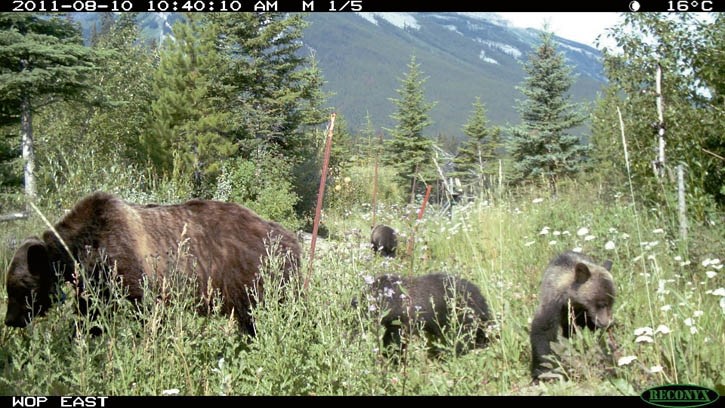Grizzly bears prefer to use overpasses to cross the deadly Trans-Canada Highway in Banff National Park.
Grizzly bears prefer to use overpasses to cross the deadly Trans-Canada Highway in Banff National Park.
That's according to the findings of 17 years of ongoing research led by Bow Valley-based scientist Tony Clevenger, who is looking into the effectiveness of highway overpasses and underpasses for wildlife.
Clevenger said there is a clear threshold for what crossing structure type grizzly bears will use and not use. Overpass and large span structures are preferred, while smaller structures are not used well by grizzlies and are of little conservation value.
“The males have adapted to and eventually used all types of crossing structures, even the smaller ones, but not nearly as often as the larger ones,” said Clevenger, a research wildlife scientist at Western Transportation Institute-Montana State University.
“For females, however, it's basically overpasses. It's a lot related to safety and security. There's a real clear preference for larger structures. We saw the same pattern with sows with cubs and young.”
Banff National Park is home to six overpasses and 38 underpasses from the east gate to the Alberta-B.C. border - the most wildlife crossing structures for any single stretch of highway anywhere in the world.
Animals need to cross the busy four-lane highway to search out mates, food, shelter, and in some cases, to escape predators. The structures are used not only by bears, but wolves, coyotes, cougars, moose, elk, deer, bighorn sheep, and more recently, wolverine and lynx.
Grizzly bears in the Bow Valley generally travel alone, the exception being females with young and occasional siblings shortly after family breakup. During mating season, researchers occasionally observed male/female pairs travelling together at crossing structures.
As part of the research, the Healy underpass west of the Banff townsite appeared to be an enigma. It has more grizzly bear crossings than any other structure in the past five years and is believed to be an important travel route for grizzlies.
Healy is a large, open span crossing structure near the confluence of three important drainages in the Bow Valley – Healy Creek, Brewster Creek and the Bow River.
This underpass is near important montane, valley bottom habitat for grizzly bears, including the reclaimed Healy Pit area with its grass and berry patches, and riparian zones north and south of the highway.
The next closest crossing structure is the Wolverine overpass, located about 2.5 kilometres west of Healy underpass. It is used a lot by most large mammals; even a wolverine was documented using it in November 2011.
Clevenger said the Wolverine overpass was built in 1997, not because it was an important area for grizzly bear travel, but because it was a hotspot for ungulates getting run over and killed on the highway.
He said the long-term monitoring and data analysis of the overpass with other wildlife crossings strongly suggests bears are capable of finding a well designed structure, learn to use it and eventually incorporate it into regular travel patterns – even if not in an optimal location.
“When the overpass was built we wondered how much grizzly bears, even wolves, would use it because basically it wasn't in the best location, but eventually they found it and started using it and using it a lot more on a regular basis,” Clevenger said.
“The structures have to be in a good location, but the type of structure trumps the location. What we've found is eventually animals find the larger structures and work them into their home ranges and start to use them.”
Research shows also there was an apparent trend towards increasing overpass use over time by grizzly bears on Phase 3B of the Trans-Canada Highway twinning project west to the Alberta-B.C border.
“The underpasses were built first, and we saw grizzly bears using the underpasses, but as soon as the overpasses were built, there was a shift in use,” Clevenger said.
Clevenger led the highway crossing research from 1996 to 2014. Partners along the way included Parks Canada, Western Transportation Institute -- Montana State University, Woodcock Foundation, Henry P. Kendall Foundation, Wilburforce Foundation and Miistakis Institute.
Clevenger said the results of the grizzly bear use of overpasses have not been published widely.
“Once this gets out, it's going to have transportation agencies think a bit differently about crossing structures and what might be best for sensitive species like grizzly bears,” he said. “Overpasses are the preferred design for maintaining grizzly bear connectivity across highways.”
